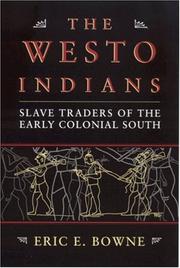| Listing 1 - 2 of 2 |
Sort by
|

ISBN: 0817382623 9780817382629 0817351787 9780817351786 0817314547 9780817314545 0817351787 9780817351786 Year: 2005 Publisher: Tuscaloosa University of Alabama Press
Abstract | Keywords | Export | Availability | Bookmark
 Loading...
Loading...Choose an application
- Reference Manager
- EndNote
- RefWorks (Direct export to RefWorks)
A comprehensive study that rescues the Westo from obscurity. The Westo Indians, who lived in the Savannah River region during the second half of the 17th century, are mentioned in few primary documents and only infrequently in secondary literature. There are no known Westo archaeological sites; no artifacts can be linked to the group; and no more than a single word of their language is known to us today. Yet, from the extant evidence, it is believed that the Westos, who migrated from around Lake Erie by 1656, had a profound effect on the development of the colonial South
Yuchi Indians --- Chisca Indians --- Euchee Indians --- Uchean Indians --- Uchee Indians --- Uchi Indians --- Westo Indians --- Youchee Indians --- Yuchian Indians --- Yutchi Indians --- Creek Indians --- Indians of North America --- Social life and customs. --- Migrations. --- History.
Book
ISBN: 0820345776 9780820345772 9780820344980 0820344982 Year: 2013 Publisher: Athens, Georgia
Abstract | Keywords | Export | Availability | Bookmark
 Loading...
Loading...Choose an application
- Reference Manager
- EndNote
- RefWorks (Direct export to RefWorks)
From approximately AD 900 to 1600, ancient Mississippian culture dominated today's southeastern United States. These Native American societies, known more popularly as moundbuilders, had populations that numbered in the thousands, produced vast surpluses of food, engaged in longdistance trading, and were ruled by powerful leaders who raised large armies. Mississippian chiefdoms built fortified towns with massive earthen structures used as astrological monuments and burial grounds. The remnants of these cities-scattered throughout the Southeast from Florida north to Wisconsin and as far west as
Mounds --- Chiefdoms --- Mississippian culture --- Barrows --- Tumuli --- Archaeology --- Landforms --- Tombs --- Temple Mound culture --- Indians of North America --- Mound-builders --- Chieftaincies --- Chieftainships --- Political anthropology --- Antiquities --- Southern States --- Antiquities.
| Listing 1 - 2 of 2 |
Sort by
|

 Search
Search Feedback
Feedback About UniCat
About UniCat  Help
Help News
News